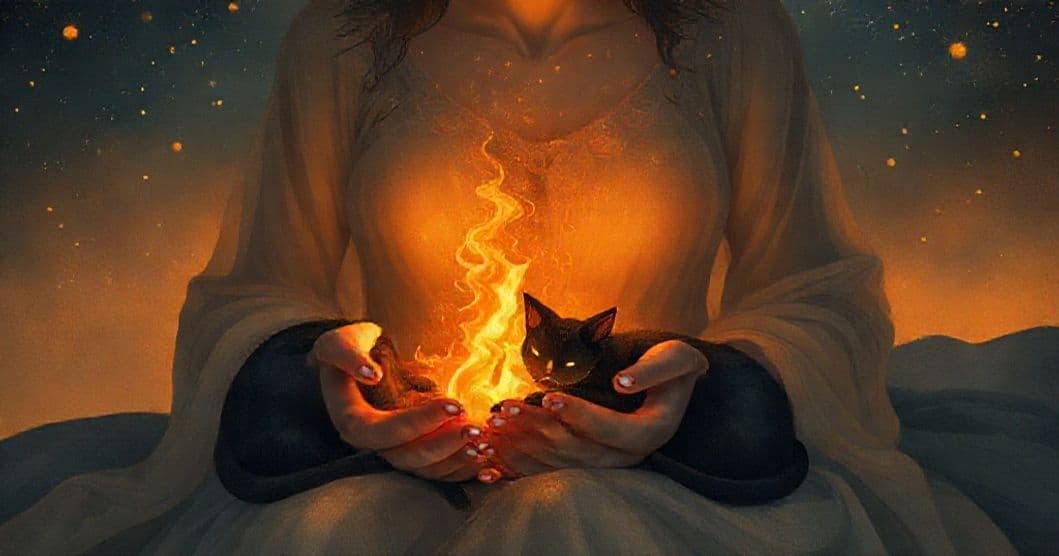Core Symbols: The Dance of Shadow and Light
The black cat in your dream is no ordinary feline—it’s a bridge between the known and unknown. In Western folklore, black cats often symbolize intuition and hidden truths, while Eastern traditions view them as protectors of ancient wisdom. But here, the cat isn’t just present; it’s cradled alongside embers, which are not flames but smoldering remnants of passion. Embers carry the heat of something once alive, now quietly glowing. Imagine holding a dying campfire: the embers aren’t fully alight, yet they pulse with potential. This duality—the cat’s mystery and embers’ warmth—creates a powerful metaphor for your inner self: a balance of hidden depth and rekindled energy.
Then there are the constellations humming. These aren’t just stars; they’re the universe’s way of whispering. In dream language, constellations represent timeless patterns and guidance—like a map etched in the sky. When they ‘hum,’ it’s not sound you hear but a felt sense of alignment, as if the cosmos itself is communicating. Together, these symbols form a tableau: you’re holding onto something precious (embers), while the universe provides direction (constellations). This isn’t random imagery; it’s your subconscious weaving together the threads of your past, present, and future.
Psychology Lens: From Jungian Shadows to REM Cycles
Want a More Personalized Interpretation?
Get your own AI-powered dream analysis tailored specifically to your dream
🔮Try Dream Analysis FreeTo truly decode this dream, we turn to psychology’s deepest wells. Carl Jung would recognize the black cat as a shadow archetype—those parts of yourself you’ve buried, yet they shape your identity. The shadow isn’t inherently negative; it’s the unknown self waiting to be integrated. The embers? They’re the shadow’s potential: repressed passions, untapped creativity, or even fears you’ve kept alive. Cradling them suggests you’re not rejecting the shadow but nurturing it.
Freud might see this differently, focusing on repressed desires. The black cat could represent a forbidden longing, and embers as the smoldering heat of that desire. But here’s the twist: the constellations add a layer of transcendence. Unlike Freud’s focus on the individual, Jung’s collective unconscious reminds us we’re part of something larger. The hum of constellations isn’t just your mind; it’s the collective wisdom of humanity, echoing through your dreams.
Neuroscience offers another lens. During REM sleep, your brain processes emotions, and the amygdala (emotion center) lights up. If you’ve felt recent uncertainty—about career, relationships, or identity—your brain might use these vivid symbols to make sense of it. The black cat’s mystery, embers’ warmth, and constellations’ calm could be your brain’s way of saying, ‘You’re on a path of transformation, even if you can’t see it yet.’
Life Triggers: When the Subconscious Speaks Through Symbols
This dream rarely appears randomly. Think about recent life shifts: a job change, ending a relationship, or even a spiritual awakening. The black cat might surface if you’re grappling with self-doubt, as it’s the archetype of ‘I don’t know who I am anymore.’ Embers spark when you’re rekindling a passion you thought dead—maybe you’re picking up an old hobby, or reconnecting with a lost friend.
The constellations hum when you’re seeking meaning in chaos. If you’ve felt adrift—no clear direction, just a sense of ‘what’s next’—your subconscious crafts this dream to remind you of your place in the universe. It’s like your inner GPS is updating: ‘Hold onto that spark, and trust the stars.’
Modern life amplifies this. In a world of digital noise, we often disconnect from our inner fire. This dream could be a nudge to slow down, feel the embers, and listen to the cosmic hum. Maybe you’ve been ignoring your intuition, and the black cat is your shadow saying, ‘I’m here—don’t leave me in the dark.’
What To Do Next: From Dream to Daily Life
Start with short-term reflection: Ask yourself, ‘When did I last feel that warmth?’ Was it during a creative moment, a deep conversation, or a time of quiet? Embers thrive in the light of attention, so name the feeling you’re nurturing. Write down the details: How did the cat feel? Was it soft, aloof, or playful? This isn’t about ‘good’ or ‘bad’—it’s about noticing.
Medium-term experimentation: Light a candle, hold it gently, and feel the heat. This mimics cradling embers. Notice if the warmth stirs something in you—a memory, a longing, or a direction. Try small acts that align with that feeling: sketch, dance, or even write a letter to someone you’ve been distant from. The constellations hum when we take steps toward our truth, so move in the direction of that warmth.
Long-term integration: Keep a ‘constellation journal.’ Every few days, note when you feel ‘humming’—a moment of clarity, a connection to something bigger. Over time, these moments will form a pattern, showing you your true north. The black cat’s mystery will fade as you embrace your shadow, and the embers will become a steady flame, not just smoldering embers.
FAQ: Answering the Unspoken Questions
Q: Is this dream a warning or a blessing? A: Neither. It’s a mirror, reflecting your inner state. If you felt comfort cradling embers, it’s a blessing of reconnection. If fear lingered, it’s a call to integrate the shadow.
Q: Why am I holding embers instead of a flame? A: Embers represent potential, not full-blown action. You might be nurturing a small spark, not a wildfire—this is about patience and intentionality.
Q: What if the constellations feel chaotic? A: Chaos in dreams often signals growth. The hum is the universe’s way of saying, ‘Trust the process, even when the map is blurry.’
